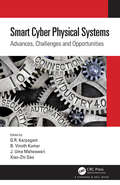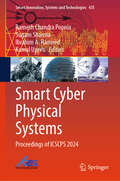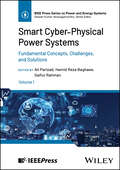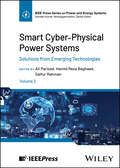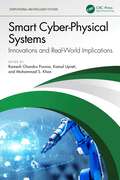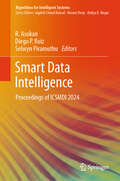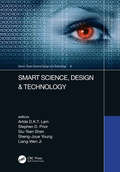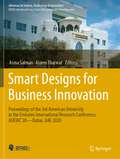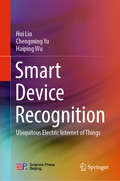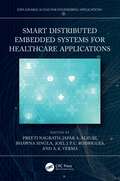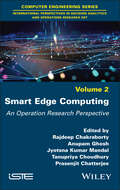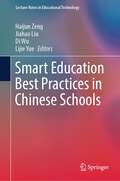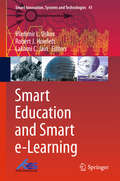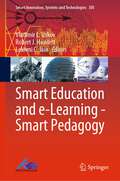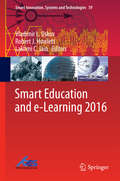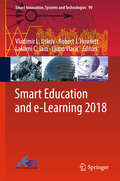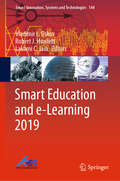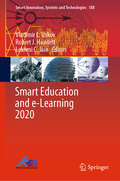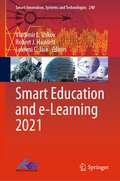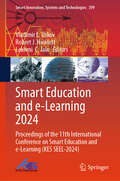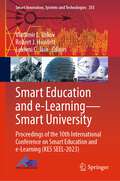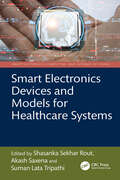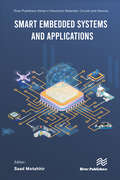- Table View
- List View
Smart Contracts and Comparative Law: A Western Perspective
by Andrea StaziThe book analyzes the most relevant developments in the relation between contracts and technology, from automatically concluded contracts to today's revolutionary "smart contracts" developed through blockchain, which are beginning to and will increasingly disrupt many economic and social relations. First of all, the author offers a broad analysis of the peculiarities and evolution of the relation between contracts and technology. The main features and elements of electronic contracts are then examined in depth to highlight the specific rules applicable to them in the international comparative legal framework. In turn, the book provides a detailed explanation of the technology, economic and social dynamics, and legal issues concerning blockchain and smart contracts. The analysis focuses on the question of the legal nature of smart contracts, the issues posed by their development and the first legal solutions adopted in some countries. The comparative approach pursued makes it possible to focus attention on the first solutions adopted until now in various systems, with particular regard to the circulation of models and ideas and to the specificities of their local variations, in terms of e.g. applicable law and jurisdiction. In reviewing the characteristics of distributed ledger technologies, and in particular of the blockchain technology on which smart contracts are based, above all the peculiarities of the latter are taken into consideration, especially automatic execution and resistance to tampering, which simultaneously present significant opportunities and complex legal issues. A comprehensive framework is then provided to reconcile smart contracts with comparative contract law, in order to define the scope and specificities of their binding force, legal effectiveness and regulation in various legal systems. Lastly, with specific reference to the elements, pathologies and contractual remedies for smart contracts, the book examines the peculiarities of their application and the main issues that emerge in comparative contract law in order to promote their harmonized use, in keeping with the transnational nature of such a revolutionary tool.
Smart Cyber Physical Systems: Advances, Challenges and Opportunities
by G.R. Karpagam, B. Vinoth Kumar, J. Uma Maheswari and Xiao-Zhi GaoSmart Cyber Physical Systems: Advances, Challenges and Opportunities ISBN: 9780367337889 Cyber Physical Systems (CPS) are the new generation of collaborative computational entities, with a prime focus on integration of the physical world and cyber space. Through a feedback mechanism, the system adapts itself to new conditions in real time. The scope of this book includes research experience by experts in CPS infrastructure systems, incorporating sustainability by embedding computing and communication in day-to-day applications. CPS, integrated with Blockchain, Artificial Intelligence, Internet of Things, Big Data, Cloud Computing and Communication, lay a foundation for the fourth industrial revolution, Industry 4.0. This book will be of immense use to practitioners in industries with a focus on autonomous and adaptive configuration, and on optimization, leading to increased agility, elasticity and cost effectiveness. The contributors of this book include renowned academics, industry practitioners and researchers. It offers a rigorous introduction to the theoretical foundations, techniques and practical solutions, through case studies. Building CPS with effective communication, control, intelligence and security is discussed in terms of societal and research perspectives. The objective of this book is to provide a forum for researchers and practitioners to exchange ideas and to achieve progress in CPS by highlighting applications, advances and research challenges. It is highly recommended to be used as a reference book for graduate and post-graduate level programmes in universities, with a focus on research in computer science-related courses.
Smart Cyber Physical Systems: Proceedings of ICSCPS 2024 (Smart Innovation, Systems and Technologies #435)
by Ramesh Chandra Poonia Kamal Upreti Ibrahim A. Hameed Sugam SharmaThis book discusses the outcome of the ICSCPS 2024 conference proceedings which provide a comprehensive exploration of Smart Cyber-Physical Systems (CPS), delivering deep into the intersection of the physical and digital worlds. The book is a must-read for researchers, engineers, students, and professionals seeking to understand and harness the power of CPS in today's technology-driven landscape. This conference's main topics encompass CPS's foundational principles, from mathematical modeling and control theory to real-time systems and cyber-security. It unravels the intricacies of sensors and actuators, shedding light on their design and applications in various domains. With a focus on communication and networks, readers will gain insights into the critical aspects of data exchange and connectivity in CPS, including wireless communication, IoT integration, and network security.
Smart Cyber-Physical Power Systems, Volume 1: Fundamental Concepts, Challenges, and Solutions (IEEE Press Series on Power and Energy Systems)
by Ali Parizad; Hamid Reza Baghaee; Saifur RahmanAuthoritative, highly comprehensive guide on how emerging technologies can address various challenges in different sectors of smart cyber-physical power systems As the world shifts towards smarter and more resilient energy systems, cyber-physical power systems (CPSs) represent a critical step in modernizing the power infrastructure. Smart Cyber-Physical Power Systems, Volume 1: Fundamental Concepts, Challenges, and Solutions, offers an in-depth exploration of the fundamental concepts, structures, and major challenges that underlie these complex systems. It covers the essential theories and frameworks that drive the integration of digital technologies with physical power systems, including smart grids, microgrids, and the Internet of Energy. This volume addresses a range of crucial topics, from global demand response strategies and microgrid architectures to smart energy management in cities and advanced distributed control strategies. Additionally, it highlights key challenges such as ensuring resiliency, protecting against cyberattacks, and maintaining reliability in the face of rapid technological advancements. Experts from around the world contribute to this volume, sharing vital insights into the transformation of traditional power systems into adaptive, cyber-physical networks. Their focus on the growing importance of privacy, security, and data analytics makes this book a critical resource for anyone involved in power system research, offering essential tools to navigate and shape the future landscapes of energy systems. Whether you’re a researcher, engineer, or industry professional, this volume provides the foundational knowledge needed to understand the evolving landscape of smart cyber-physical power systems and the significant challenges they face. Join us on a journey through the landscape of Smart Cyber-Physical Power Systems (CPPSs), where cutting-edge solutions meet the challenges of today and forge the energy paradigms of tomorrow, driven by AI/ML, Big Data, Blockchain, IoT, Quantum Computing, Information Theory, Edge Computing, Metaverse, DevOps, and more.
Smart Cyber-Physical Power Systems, Volume 2: Solutions from Emerging Technologies (IEEE Press Series on Power and Energy Systems)
by Saifur Rahman Ali Parizad Hamid Reza BaghaeeA practical roadmap to the application of artificial intelligence and machine learning to power systems In an era where digital technologies are revolutionizing every aspect of power systems, Smart Cyber-Physical Power Systems, Volume 2: Solutions from Emerging Technologies shifts focus to cutting-edge solutions for overcoming the challenges faced by cyber-physical power systems (CPSs). By leveraging emerging technologies, this volume explores how innovations like artificial intelligence, machine learning, blockchain, quantum computing, digital twins, and data analytics are reshaping the energy sector. This volume delves into the application of AI and machine learning in power system optimization, protection, and forecasting. It also highlights the transformative role of blockchain in secure energy trading and digital twins in simulating real-time power system operations. Advanced big data techniques are presented for enhancing system planning, situational awareness, and stability, while quantum computing offers groundbreaking approaches to solving complex energy problems. For professionals and researchers eager to harness cutting-edge technologies within smart power systems, Volume 2 proves indispensable. Filled with numerous illustrations, case studies, and technical insights, it offers forward-thinking solutions that foster a more efficient, secure, and resilient future for global energy systems, heralding a new era of innovation and transformation in cyber-physical power networks. Welcome to the exploration of Smart Cyber-Physical Power Systems (CPPSs), where challenges are met with innovative solutions, and the future of energy is shaped by the paradigms of AI/ML, Big Data, Blockchain, IoT, Quantum Computing, Information Theory, Edge Computing, Metaverse, DevOps, and more.
Smart Cyber-Physical Systems: Innovations and Real-World Implications (Computational and Intelligent Systems)
by Ramesh Chandra Poonia Kamal Upreti Mohammad S. KhanSmart cyber‑physical systems (SCPS) are revolutionizing the interaction between the physical and digital realms, driving innovation across diverse fields. This book provides an extensive overview of cutting‑edge SCPS technologies, highlighting their applications, challenges, and transformative potential. Designed for researchers, professionals, and students, it offers foundational insights and advanced applications in urban planning, healthcare, transportation, finance, and cybersecurity. It also bridges the gap between theory and practice through real‑world case studies and in‑depth analysis, showcasing how SCPS address critical global challenges. This book: Provides a comprehensive introduction to SCPS, their components, and their applications in various domains and explores their role in enabling sustainable smart cities and urban planning Provides advanced SCPS‑based solutions for optimizing supply chain logistics and route planning and real‑world applications of SCPS in healthcare, including wearable technology and remote patient monitoring, and financial modeling, comparing investment indices using advanced techniques Discusses the integration of artificial intelligence and machine learning in autonomous vehicle systems and transportation Analyzes cybersecurity challenges in cryptocurrency and blockchain ecosystems Focuses on innovations in energy management, including smart grids and sustainable practices powered by SCPS, and explores adaptive human–machine interaction frameworks for enhanced decision‑making This book serves as a vital resource for understanding the transformative power of SCPS and inspires further research and development in this dynamic and rapidly evolving field.
Smart Data Intelligence: Proceedings of ICSMDI 2022 (Algorithms for Intelligent Systems)
by Selwyn Piramuthu Zubair A. Baig R. Asokan Diego P. RuizThis book presents high-quality research papers presented at 2nd International Conference on Smart Data Intelligence (ICSMDI 2022) organized by Kongunadu College of Engineering and Technology at Trichy, Tamil Nadu, India, during April 2022. This book brings out the new advances and research results in the fields of algorithmic design, data analysis, and implementation on various real-time applications. It discusses many emerging related fields like big data, data science, artificial intelligence, machine learning, and deep learning which have deployed a paradigm shift in various data-driven approaches that tends to evolve new data-driven research opportunities in various influential domains like social networks, healthcare, information, and communication applications.
Smart Data Intelligence: Proceedings of ICSMDI 2024 (Algorithms for Intelligent Systems)
by Selwyn Piramuthu R. Asokan Diego P. RuizThis book presents high-quality research papers presented at 4th International Conference on Smart Data Intelligence (ICSMDI 2024) organized by Kongunadu College of Engineering and Technology at Trichy, Tamil Nadu, India, during February 2024. This book brings out the new advances and research results in the fields of algorithmic design, data analysis, and implementation on various real-time applications. It discusses many emerging related fields like big data, data science, artificial intelligence, machine learning, and deep learning which have deployed a paradigm shift in various data-driven approaches that tends to evolve new data-driven research opportunities in various influential domains like social networks, health care, information, and communication applications.
Smart Design, Science & Technology: Proceedings of the IEEE 6th International Conference on Applied System Innovation (ICASI 2020), November 5-8, 2020, Taitung, Taiwan (Smart Science, Design & Technology)
by Artde Donald Kin-Tak LamSmart Design, Science & Technology represents the proceedings of the IEEE 6th International Conference on Applied System Innovation (ICASI 2020), which was held in Taitung, Taiwan November 5-8, 2020. The conference received more than 200 submitted papers from at least 11 different countries, whereby roughly one third of these papers was selected by the committees and invited to present at ICASI 2020. This book aims to provide an integrated communication platform for researchers from a wide range of disciplines including information technology, communication science, applied mathematics, computer science, advanced material science, and engineering. Only high quality papers were allowed to publish in the volume. Hopefully, interdisciplinary collaborations between science and engineering technologists in academia and industry will be enhanced via this unique international network.
Smart Designs for Business Innovation: Proceedings of the 3rd American University in the Emirates International Research Conference, AUEIRC’20—Dubai, UAE 2020 (Advances in Science, Technology & Innovation)
by Asma Salman Assem TharwatThis book, and the papers published within it, delves into the topic of governance in a modern, digital age, deliberating upon digital finance, societal security, and digital governance, proving essential to governmental institutions, policymakers, economists, and finally, social educators. The formation of a prosperous and resilient society is, without a doubt, a daunting, monumental task. Addressing people’s needs, maintaining their well-being, ensuring safety from external threats, and implementing a just law system that covers contemporary ways of life are no simple task. Thankfully, the advent of technological advancement helps lighten the heavy burden of governance. The element of interconnectedness brought forward by technological innovation has bridged the gap between society and government, allowing for faster interactions through the digitalization of naturally bureaucratic processes, and the utilization of digital finances.
Smart Device Recognition: Ubiquitous Electric Internet of Things
by Hui Liu Chengming Yu Haiping WuThe book is the first international reference on the field of smart device recognition and Ubiquitous Electric Internet of Things (UEIOT). It presents a range of state-of-the-art key methods and applications for smart device recognition. In future smart environments, obtaining energy consumption information for identifying every device is an effective approach to guarantee the energy efficiency of smart industrial systems. Such as, the Ubiquitous Electric Internet of Things (UEIOT) technology represents one of the most effective measures for electricity and energy management and has attracted considerable attention from scientists and engineers around the world. The realization of smart device recognition in the UEIOT framework has become the core and basis of UEIOT’s success. The device smart recognition can help governments and managers to distribute energy and power better, and help device manufacturers to improve their products regarding smart energy conservation. Accordingly, in the future smart industry, implementing smart device recognition is desired and very important. In the book, several methods, strategies, and experiments for achieving smart device recognition are presented in details. As the first monograph in the field of smart device recognition, the book can provide beneficial reference for students, engineers, scientists, and managers in the fields of power, energy, electromechanical devices, smart cities, artificial intelligence, etc.
Smart Distributed Embedded Systems for Healthcare Applications (Explainable AI (XAI) for Engineering Applications)
by Jafar A. Alzubi Joel J. P. C. Rodrigues Bhawna Singla Preeti Nagrath A. K. VermaThis book discusses the applications and optimization of emerging smart technologies in the field of healthcare. It further explains different modeling scenarios of the latest technologies in the healthcare system and compares the results to better understand the nature and progress of diseases in the human body, which would ultimately lead to early diagnosis and better treatment and cure of diseases with the help of distributed technology. Covers the implementation models using technologies such as artificial intelligence, machine learning, and deep learning with distributed systems for better diagnosis and treatment of diseases. Gives in-depth review of technological advancements like advanced sensing technologies such as plasmonic sensors, usage of RFIDs, and electronic diagnostic tools in the field of healthcare engineering. Discusses possibilities of augmented reality and virtual reality interventions for providing unique solutions in medical science, clinical research, psychology, and neurological disorders. Highlights the future challenges and risks involved in the application of smart technologies such as cloud computing, fog computing, IOT, and distributed computing in healthcare. Confers to utilize the AI and ML and associated aids in healthcare sectors in the post-Covid 19 period to revitalize the medical setup. Contributions included in the book will motivate technological developers and researchers to develop new algorithms and protocols in the healthcare field. It will serve as a vast platform for gaining knowledge regarding healthcare delivery, health- care management, healthcare in governance, and health monitoring approaches using distributed environments. It will serve as an ideal reference text for graduate students and researchers in diverse engineering fields including electrical, electronics and communication, computer, and biomedical fields.
Smart Edge Computing: An Operation Research Perspective
by Jyotsna Kumar Mandal Tanupriya Choudhury Prasenjit Chatterjee Rajdeep Chakraborty Anupam GhoshThis book pioneers the synergy between state-of-the-art edge computing technologies and the power of operations research. It comprehensively explores real-world applications, demonstrating how various operations' research techniques enhance edge computing’s efficiency, reliability and resource allocation. Innovative solutions for dynamic task scheduling, load balancing and data management, all tailored to the unique challenges of edge environments, are displayed. Starting with operation research methodologies with foundations, applications and research challenges in edge computing and an overview of digital education, this book continues with an exploration of applications in the health sector using IoT, intelligent payment procedures and performance measurement of edge computing, using edge computing and operation research. Smart or AI-based applications are also explored further on and the book ends with insight into ultralightweight and security protocols with solutions for IoT using blockchain.
Smart Education Best Practices in Chinese Schools (Lecture Notes in Educational Technology)
by Di Wu Haijun Zeng Jiahao Liu Lijie YueThis book presents 28 practical case studies in detail and 49 case studies in brief. The collection of these case studies focuses on one or more aspects of exploration and practice on the following topics: smart campus and smart classroom, resource construction and sharing, new teaching mode, comprehensive quality evaluation of students, teacher professional development, application of teaching platform and tool, innovative application of online learning space, collaborative education, and school management and services. The selection and evaluation criteria of the case studies on school practice mainly include concept and implementation, effectiveness and characteristics, innovation and demonstration, and expression and structure. This book helps readers gain a rich understanding of the diverse innovative implementation of smart education in Chinese schools and inspires smart education development in schools in other countries.
Smart Education and Smart e-Learning
by Lakhmi C. Jain Robert J. Howlett Vladimir L. UskovThis book contains the contributions presented at the 2nd international KES conference on Smart Education and Smart e-Learning, which took place in Sorrento, Italy, June 17-19, 2015. It contains a total of 45 peer-reviewed book chapters that are grouped into several parts: Part 1 - Smart Education, Part 2 - Smart Educational Technology, Part 3 - Smart e-Learning, Part 4 - Smart Professional Training and Teachers' Education, and Part 5 - Smart Teaching and Training related Topics. This book can be a useful source of research data and valuable information for faculty, scholars, Ph. D. students, administrators, and practitioners - those who are interested in innovative areas of smart education and smart e-learning.
Smart Education and e-Learning - Smart Pedagogy (Smart Innovation, Systems and Technologies #305)
by Lakhmi C. Jain Robert J. Howlett Vladimir L. UskovThis book serves as a reference for researchers and practitioners in academia and industry. Smart education, smart e-learning and smart pedagogy are emerging and rapidly growing areas that have a potential to transform existing teaching strategies, learning environments and educational activities and technology. They are focused at enabling instructors to develop innovative ways of achieving excellence in teaching in highly technological smart university and providing students with new opportunities to maximize their success using smart classrooms, smart systems and technology. This book contains the contributions presented at the 9th international KES conference on Smart Education and e-Learning (SEEL-2022) with the Smart Pedagogy as the main conference theme. It comprises of forty nine high-quality peer-reviewed papers that are grouped into several interconnected parts: Part 1—Smart Pedagogy, Part 2—Smart Education, Part 3—Smart e-Learning, Part 4—Smart University, Part 5—Smart Education: Systems and Technology, Part 6—Digital Humanities and Social Sciences for Smart University Development: the Innovative Methods, Models and Technologies, Part 7—Digital Transformation of Education and Economics in Smart University and Part 8—Smart Education for Children with Special Educational Needs. We believe this book will serve as a useful source of research data and valuable information for faculty, scholars, Ph.D. students, administrators and practitioners—those who are interested in smart education, smart e-learning and smart pedagogy.
Smart Education and e-Learning 2016
by Lakhmi C. Jain Robert J. Howlett Vladimir L. UskovThis book contains the contributions presented at the 3rd international KES conference on Smart Education and Smart e-Learning, which took place in Puerto de la Cruz, Tenerife, Spain, June 15-17, 2016. It contains a total of 56 peer-reviewed book chapters that are grouped into several parts: Part 1 - Smart University: Conceptual Modeling, Part 2 - Smart Education: Research and Case Studies, Part 3 - Smart e-Learning, Part 4 - Smart Education: Software and Hardware Systems, and Part 5 - Smart Technology as a Resource to Improve Education and Professional Training. We believe that the book will serve as a useful source of research data and valuable information for faculty, scholars, Ph. D. students, administrators, and practitioners - those who are interested in innovative areas of smart education and smart e-learning.
Smart Education and e-Learning 2018: Proceedings Of The 5th International Kes Conference On Smart Education And E-learning (kes-seel-18) (Smart Innovation, Systems And Technologies #99)
by Lakhmi C. Jain Robert J. Howlett Vladimir L. Uskov Ljubo VlacicThis book features the contributions presented at the 5th International KES Conference on Smart Education and e-Learning, which took place in Gold Coast, Australia, June 20–22, 2018. The peer-reviewed papers are grouped into several interconnected parts: Part 1 – Smart Education: Systems and Technology, Part 2 – Smart Pedagogy, Part 3 – Smart Education: Case Studies and Research, and Part 4: Sustainable Learning Technologies: Smart Higher Education Futures. Smart education and smart e-learning are emerging and rapidly growing areas with the potential to transform existing teaching strategies, learning environments, and educational activities and technology in the classroom. Smart education and smart e-learning focus on enabling instructors to develop new ways of achieving excellence in teaching in highly technological smart classrooms, and providing students with new opportunities to maximize their success and select the best options for their education, location and learning style, as well as the mode of content delivery. This book serves as a useful source of research data and valuable information on current research projects, best practices and case studies for faculty, scholars, Ph.D. students, administrators, and practitioners – all those who are interested in smart education and smart e-learning.
Smart Education and e-Learning 2019 (Smart Innovation, Systems and Technologies #144)
by Lakhmi C. Jain Robert J. Howlett Vladimir L. UskovThis book contains the contributions presented at the 6th international KES conference on Smart Education and e-Learning (KES SEEL-2019), which took place at St. Julian’s, Malta, June 17–19, 2019. It contains fifty-five high-quality peer-reviewed papers that are grouped into several interconnected parts: Part 1 – Smart Education, Part 2 – Smart e-Learning, Part 3 – Smart Pedagogy, Part 4 – Smart Education: Systems and Technology, Part 5 – Smart Education: Case Studies and Research, Part 6 – Students with Disabilities and Smart Education/University, and Part 7 – Mathematical Modelling of Smart Education and Economics of Smart University. Smart education and smart e-learning are emerging and rapidly growing areas with the potential to transform existing teaching strategies, learning environments, and educational activities and technology in the classroom. Smart education and smart e-learning focus on enabling instructors to develop new ways of achieving excellence in teaching in highly technological smart classrooms, and providing students with new opportunities to maximize their success and select the best options for their education, location and learning style, as well as the mode of content delivery. This book serves as a useful source of research data and valuable information on current research projects, best practices and case studies for faculty, scholars, Ph.D. students, administrators, and practitioners – all those who are interested in smart education and smart e-learning.
Smart Education and e-Learning 2020: Proceedings Of The 7th International Kes Conference On Smart Education And E-learning (kes Seel-2020) (Smart Innovation, Systems and Technologies #188)
by Lakhmi C. Jain Robert J. Howlett Vladimir L. UskovThis book contains the contributions presented at the 7th international KES conference on Smart Education and e-Learning (KES SEEL-2020), which being held as a virtual conference on June 17-19, 2020. It contains fifty three high quality peer-reviewed papers that are grouped into several interconnected parts: Part 1 – Smart Education, Part 2 – Smart e-Learning, Part 3 – Smart Pedagogy, Part 4 - Smart Education: Systems and Technology, Part 5 – Smart Education: Case Studies and Research, Part 6 - Smart University Development: Organizational and Managerial Issues, Part 7 - Smart Education and Smart Universities and their Impact on Students with Disabilities, Part 8 - Mathematical Models in Smart Education and e-Learning, and Part 9 - Models of Professional Practice in Higher Education.Smart education and smart e-learning are emerging and rapidly growing areas with the potential to transform existing teaching strategies, learning environments, and educational activities and technology in the classroom. Smart education and smart e-learning focus on enabling instructors to develop new ways of achieving excellence in teaching in highly technological smart classrooms, and providing students with new opportunities to maximize their success and select the best options for their education, location and learning style, as well as the mode of content delivery. This book serves as a useful source of research data and valuable information on current research projects, best practices and case studies for faculty, scholars, Ph.D. students, administrators, and practitioners – all those who are interested in smart education and smart e-learning.
Smart Education and e-Learning 2021 (Smart Innovation, Systems and Technologies #240)
by Lakhmi C. Jain Robert J. Howlett Vladimir L. UskovThis book contains the contributions presented at the 8th International KES Conference on Smart Education and e-Learning (KES SEEL 2021), which being held as a virtual conference on June 14–16, 2021. It contains high-quality peer-reviewed papers that are grouped into several interconnected parts: smart education; smart e-learning; smart education: systems and technology; smart education: case studies and research; digital education and economics in smart university, smart university development: organizational, managerial and social Issues; smart universities and their Impact on students with disabilities. This book serves as a useful source of research data and valuable information on current research projects, best practices, and case studies for faculty, scholars, Ph.D. students, administrators, and practitioners— all those who are interested in smart education and smart e-learning.
Smart Education and e-Learning 2024: Proceedings of the 11th International Conference on Smart Education and e-Learning (KES SEEL-2024) (Smart Innovation, Systems and Technologies #399)
by Lakhmi C. Jain Robert J. Howlett Vladimir L. UskovThis book contains the contributions presented at the 11th international KES conference on Smart Education and e-Learning (SEEL-2024) with the Smart University as the main conference theme. The conference is being held on June 19-21, 2024 in Madeira, Portugal in both in-person and online modes. The book contains high quality peer-reviewed papers that are grouped into several interconnected parts: Part 1 – Smart Education, Part 2 – Smart e-Learning, Part 3 – Smart University, Part 4 – Smart Education: Case Studies and Research, and Part 5 – Smart Company: Case Studies and Research. Smart education, smart e-learning, smart universities and smart companies are emerging and rapidly growing areas with the potential to transform the existing teaching strategies, learning environments, and educational/training activities and technology in academic institutions and training centers. Smart education/training and smart e-learning are focused on enabling instructors/trainers to develop innovative ways of achieving excellence in teaching in highly technological smart classrooms/labs, and providing students/learners with new opportunities to maximize their success and select the best options for their education/training, location and learning style, as well as the mode of content delivery. This book serves as a useful source of research data and valuable information on current research projects, best practices and case studies for faculty, scholars, Ph.D. students, administrators, and practitioners – all those who are interested in smart education, smart e-learning, smart university and smart business/company paradigms, concepts, systems and technology.
Smart Education and e-Learning—Smart University: Proceedings of the 10th International Conference on Smart Education and e-Learning (KES SEEL-2023) (Smart Innovation, Systems and Technologies #355)
by Lakhmi C. Jain Robert J. Howlett Vladimir L. UskovThis book contains the contributions presented at the 10th international KES conference on Smart Education and e-Learning (SEEL-2023) with the Smart University as the main conference theme. The conference is being held on June 14-16, 2023 in Rome, Italy in both in-person and online modes. The book contains high quality peer-reviewed papers that are grouped into several interconnected parts: Part 1 – Smart Education, Part 2 – Smart e-Learning, Part 3 – Smart University, Part 4 – Smart Education: Case Studies and Research, and Part 5 – Smart Company: Case Studies and Research. Smart education, smart e-learning, smart universities and smart companies are emerging and rapidly growing areas with the potential to transform the existing teaching strategies, learning environments, and educational/training activities and technology in academic institutions and training centers. Smart education/training and smart e-learning are focused on enabling instructors/trainers to develop innovative ways of achieving excellence in teaching in highly technological smart classrooms/labs, and providing students/learners with new opportunities to maximize their success and select the best options for their education/training, location and learning style, as well as the mode of content delivery. This book serves as a useful source of research data and valuable information on current research projects, best practices and case studies for faculty, scholars, Ph.D. students, administrators, and practitioners – all those who are interested in smart education, smart e-learning, smart university and smart business/company paradigms, concepts, systems and technology.
Smart Electronics Devices and Models for Healthcare Systems (Smart Electronics, Computing, and Internet of Things)
by Suman Lata Tripathi Akash Saxena Shasanka Sekhar RoutIn light of recent environmental catastrophes and the COVID-19 pandemic, healthcare has received renewed focus and consideration from researchers across disciplines.Smart Electronics Devices and Models for Healthcare Systems offers a comprehensive exploration of the intersection between technology and healthcare, providing insights into the design, implementation, and impact of smart electronic devices and models in modern healthcare systems.With special emphasis on the Internet of Medical Things and Internet of Things technologies, this book delves into sensors design, measuring equipment, signal processing blocks, medical data processing blocks, and assistive technologies. Major focus areas include: Use of 5G technologies for the design and development of smart electronic devices and applications. Development of wireless sensor networks-based real-time healthcare infrastructure and e-health platform. Design and deployment of medical devices for the Internet of Things and Internet of Medical Things platforms such as remote patient monitoring technology. Illustrate the design and development of devices for emergent digital technologies such as telemedicine, artificial intelligence, and augmented reality. Explore robotic assistance models for medical practices, in order to improve patient care and accessibility. This book is primarily written for senior undergraduates, graduate students, and academic researchers in the fields of electrical engineering, electronics and communications engineering, computer science and engineering, and biomedical engineering.
Smart Embedded Systems and Applications
by Saad MotahhirThis book covers a wide range of challenges, technologies and state-of-the-art for the design, development and realization of smart and complex embedded systems and their applications; i.e., software and hardware development, with the use of digital technologies, and quality assurance for critical applications. This book starts with automotive safety systems which is one of the major functional domains. It discusses the importance of software in automotive systems followed by an insight into Automotive Software Standards, ISO26262, and Autosar. The book further discusses the use of Processor in the loop test for an adaptive trajectory tracking control for quadrotor UAVs. It also illustrates the role of embedded systems in medical engineering. Various innovative applications involving the concept of image processing and Internet of Things are also presented in this book. The SoC Power Estimation is also investigated. Finally, a Review of the Hardware/Software Partitioning Algorithms with some future works have been presented. this book is intended for academicians, researchers, and industrialists.

